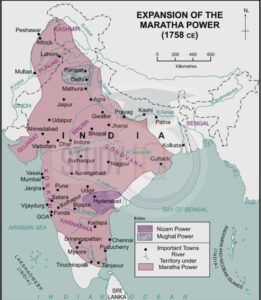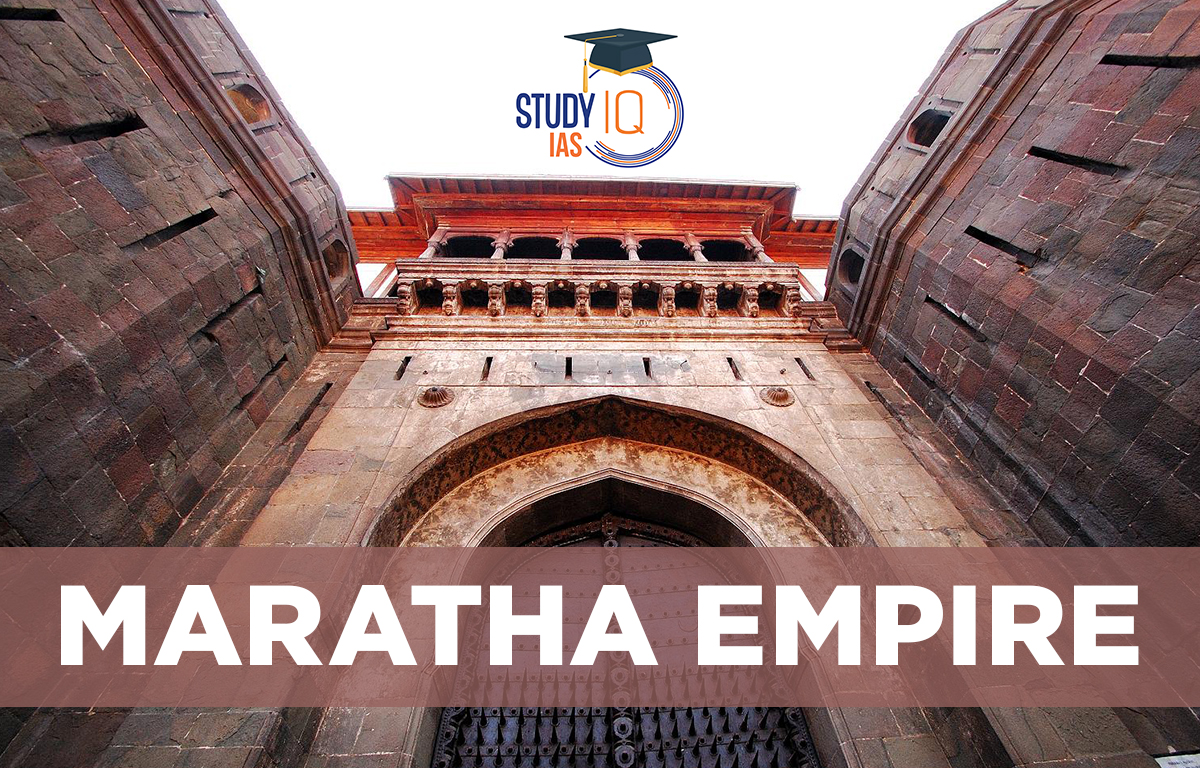Table of Contents
Maratha Empire
The Maratha Empire, which was the most powerful of the successor nations, posed the greatest threat to the waning Mughal power. In actuality, it was the only entity strong enough to fill the political void left by the collapse of the Mughal Empire. In the seventeenth century, a small kingdom known as the Maratha was established in western India.
In defiance of the Mughal army’s efforts and intense local opposition from the Muslim Kingdom of Bijapur, it was founded by the Maratha chief Shivaji. For UPSC Exam Preparation, this article contains all the necessary information regarding the Maratha Empire. To learn more about UPSC Syllabus visit the official website of StudyIQ.
Maratha Empire History
Analyzing Chhatrapati Shivaji Maharaj’s series of uprisings against the Mughal Empire and the Bijapur Sultanate will help us understand how the Maratha Empire came to be. His guiding idea was based on Hindawi Swarajya. The independent Maratha Kingdom with Raigad as its capital was established by Shivaji Maharaj.
Shambhu Raje, who was born on May 14, 1657, fought Aurangzeb in the Deccan during the Eight Years’ War. Sambhaji was captured by the Mughal Emperor in 1689 while travelling to see the commanders at Sangameshwar. For sending the Maratha army back, Aurangazeb imprisoned him and then had him executed.
Later, Aurangzeb abducted the family of Chhatrapati Shivaji in order to seize control of Raigad’s city. Rajaram, Sambhaji’s half-brother, seized the Chhatrapati throne in 1690. Jinji fort hosted his coronation ceremony (present-day Tamil Nadu). Aurangzeb, the Mughal emperor, set off a string of uprisings against the Marathas. Chhatrapati Rajaram relocated to Berar and most likely passed away around 1700 at Sinhagad in Pune.
Maratha Empire Map
Here is the Map of the Expansion of the Maratha Empire shown below:

Maratha Empire Period
After the Marathas defeated the Mughals in 1674, Shivaji was given the honour of being referred to as the Chhatrapati (meaning king) of the newly established Maratha Kingdom. The Maratha kingdom was reinforced with massive forts and other naval structures during his final years.
The emergence of the Marathas and the Maratha Empire surged dramatically in terms of size and prospered in other areas as well in the early eighteenth century, under the rule of his grandson. Sambhaji (Shambhu Raje), the eldest son of Chhatrapati Shivaji Maharaj, controlled the Maratha Empire in 1681.
He ruthlessly carried out Shivaji’s agenda of expansion, defeating the Portuguese and Chikka Deva Raya of Mysore. Their spheres of influence were widened as a result. The Mughal Emperor Aurangazeb was angered by these events and launched an expedition against the Marathas.
Maratha Empire Kings
This list has information about the Maratha Empire Kings. Go through the complete list of Maratha Empire Kings. Below given is the list:
| Maratha Empire | Timeline | Description |
| Shri Chhatrapati Shivaji Maharaj | (c. 1627-1680) | The Maratha monarchy was established by him. He belonged to the Bhonsale Maratha family. He is regarded as the greatest soldier of his era. |
| Sambhaji (Sambhaji) | (c. 1681-1689) | The second Chhatrapati of the Maratha Empire and the eldest son of Shivaji Maharaj. |
| Tarabai and Rajaram | (c. 1689-1707) | She was Shivaji’s daughter-in-law and the ruler of Rajaram Bhosale. The Maratha empire’s third Chhatrapati was Rajaram. He governed from 1689 and 1700. |
| Shahu | (c. 1707-1749) | He was a true democrat and social reformer. He was also the first Kohlapur maharaja. |
| Bawdekar, Amatya Ramchandra Pant | (1650-1716) | In the years 1674 to 1680, he was Chhatrapati Shivaji Maharaj’s finance minister. He was a statesman at the time, but he was also a fighter. |
| Peshwa Baji Rao | (1720-1740) | During his 20-year reign as a Peshwa, Baji Rao overcame the Mughals and their subordinate Nizam-ul-Mulk. He engaged in numerous conflicts, including the Battle of Delhi and others. |
| Baji Rao, Peshwa Balaji | (1740-1761) | Balaji Vishwanath died in 1720, and the 20-year-old Baji Rao was chosen to succeed him as Peshwa, over the chieftains’ objections. |
Maratha Empire Family Tree
Here is a simplified Maratha Empire Family Tree given below:

Maratha Kingdom & Anglo-Maratha Wars
First Anglo-Maratha War
The First Anglo-Maratha War was caused by the power struggle between Sawai Madhav Rao and Raghunath Rao, which the British supported. The Anglo-Maratha War was resolved by the Treaty of Salbai in May 1782, which recognised Madhavrao as the Peshwa of the Maratha Empire.
Second Anglo-Maratha War
The defeat of Peshwa Baji Rao II by the Holkar (one of the most powerful Maratha clans) and his acceptance of the subsidiary alliance (Treaty of Bassein) in 1802 led to the second war. The unhappy Maratha Confederacy attempted to challenge British supremacy but was unsuccessful.
Third Anglo-Maratha War
Distressed with poor earnings The multi-caste Pindaris began pillaging neighbouring lands, including those of businesses. In order to justify his war efforts, Governor General Lord Hasting accused the Marathas of providing shelter to the Pindaris. The Maratha warlords engaged in solitary combat rather than assembling a unified front, and they each submitted one by one.
Marathas Empire Decline
The Maratha aspiration to dominate the Mughal Empire and build their own empire over a sizable portion of the nation was unsuccessful. The Maratha chiefs joined together loosely. Only when there was a strong central authority did they work together to defeat the shared foe. They tended to establish their independence whenever there was an opportunity. The Maratha Sardars never made an effort to create a new economy. They failed to promote trade and industry, as well as research and technology.
The Marathas faced opposition from the British as well. During the Second Maratha War (1803-05) and the Third Maratha War, they defeated the Maratha Chiefs by employing a divide-and-conquer strategy (1816-1819). The outcome was that numerous Maratha states joined the British in a subsidiary alliance, and the Peshwas family was destroyed.
Maratha Empire UPSC
In Indian history, the Maratha Empire is a crucial subject. The Maratha Empire has been the subject of numerous questions in both the UPSC Preliminary and Main Examinations. The Maratha Empire is a crucial and fundamental component of the UPSC, and applicants must thoroughly prepare for the tests in order to succeed. Visit the official website of StudyIQ UPSC Online Coaching for UPSC Exam preparations.


 Nagari Pracharini Sabha Revival: Backgro...
Nagari Pracharini Sabha Revival: Backgro...
 Ryotwari System in India, Features, Impa...
Ryotwari System in India, Features, Impa...
 Battle of Plassey, History, Causes, Impa...
Battle of Plassey, History, Causes, Impa...





















